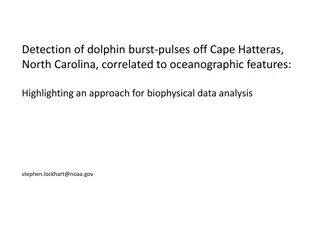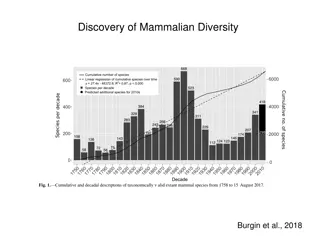Discovering Individual Whale and Dolphin Species Through Research
Dive into the fascinating world of whale and dolphin species with a focus on individual identification, habitats, and unique features. From the iconic Bottlenose Dolphin to the majestic Humpback Whale, learn about their lives, behaviors, and how researchers study and conserve these incredible marine creatures.
Download Presentation

Please find below an Image/Link to download the presentation.
The content on the website is provided AS IS for your information and personal use only. It may not be sold, licensed, or shared on other websites without obtaining consent from the author.If you encounter any issues during the download, it is possible that the publisher has removed the file from their server.
You are allowed to download the files provided on this website for personal or commercial use, subject to the condition that they are used lawfully. All files are the property of their respective owners.
The content on the website is provided AS IS for your information and personal use only. It may not be sold, licensed, or shared on other websites without obtaining consent from the author.
E N D
Presentation Transcript
Cetacean BINGO Call list #2
1. These dolphins are commonly found in zoos and aquaria. One female has lived in an aquarium at Marineland, Florida for more than 58 years. ANSWER: Bottlenose dolphin Lesson 3 Researching Individual Whale and Dolphin Species
2. Northern right whale dolphin Photo credit: NOAA Lesson 3 Researching Individual Whale and Dolphin Species
3. Sei whale Lesson 3 Researching Individual Whale and Dolphin Species
4. These whales can be recognized by the big white growths ( callosities ) on their heads. Unique patterns of callosities are used to identify individual animals ANSWER: North Atlantic right whale Lesson 3 Researching Individual Whale and Dolphin Species
5. Atlantic spotted dolphin Lesson 3 Researching Individual Whale and Dolphin Species
6. Males of this whale have two small teeth that stick out of the lower jaw, which they use for fighting. ANSWER: Cuvier s beaked whale Lesson 3 Researching Individual Whale and Dolphin Species
7. This whale is famous for its songs. Males repeatedly sing songs of 10- 20 min each for hours on end. Individual whales can be identified by their unique songs. ANSWER: Humpback whale Lesson 3 Researching Individual Whale and Dolphin Species
8. Bryde s whale Lesson 3 Researching Individual Whale and Dolphin Species
9. Calves of this whale species can gain weight at a rate of 10 lbs per hour. ANSWER: Blue whale Lesson 3 Researching Individual Whale and Dolphin Species
10. Rough-toothed dolphin Lesson 3 Researching Individual Whale and Dolphin Species
11. This whale s tongue is half yellow or white and half mottled black. ANSWER: Fin whale Lesson 3 Researching Individual Whale and Dolphin Species
12. These mysticetes are fast swimmers; they can swim up to 21 miles per hour! ANSWER: Minke whale Lesson 3 Researching Individual Whale and Dolphin Species
13. Northern bottlenose whale Lesson 3 Researching Individual Whale and Dolphin Species
14. Common dolphin Lesson 3 Researching Individual Whale and Dolphin Species
15. These whales have white barnacles on their head, and may also have orange crab-like animals, called cyamids, on their bodies. Photo credit: Merrill Gosho, NOAA ANSWER: Gray whale Lesson 3 Researching Individual Whale and Dolphin Species
16. Risso s dolphin Lesson 3 Researching Individual Whale and Dolphin Species
17. Vaquita Photo credit: Uko Gorter Lesson 3 Researching Individual Whale and Dolphin Species
18. This whale is the same type as the famous Moby Dick . Adult males have been documented occasionally striking boats for unknown reasons, causing very severe damage. ANSWER: Sperm whale Lesson 3 Researching Individual Whale and Dolphin Species
19. False killer whale Lesson 3 Researching Individual Whale and Dolphin Species
20. Pacific white-sided dolphin Lesson 3 Researching Individual Whale and Dolphin Species
21. Historically, this dolphin inhabited the Yangtze River in China. Sadly, it is now believed to be extinct. ANSWER: Chinese river dolphin Image credit: Alessio Marrucci Lesson 3 Researching Individual Whale and Dolphin Species
22. This whale is severely threatened by climate change. As more Arctic ice melts, ship traffic in its home range increases. This whale is at greater risk of being hit by ships. ANSWER: Narwhal Photo credit:NOAA/University of Washington Lesson 3 Researching Individual Whale and Dolphin Species
23. Harbor porpoise Lesson 3 Researching Individual Whale and Dolphin Species
24. Bowhead whale Lesson 3 Researching Individual Whale and Dolphin Species
25. This small toothed whale usually travels in large groups of 20 to 90 animals. These whales are involved in mass stranding events along the Florida coastline every few years. Some of these stranding events may involve more than 100 animals coming onshore at the same time. ANSWER: Short-finned pilot whale Image credit: Garth Mix Lesson 3 Researching Individual Whale and Dolphin Species
26. A few of these whales are kept in captivity. Some of these have lived in Florida for more than 40 years. ANSWER: Orca/killer whale Lesson 3 Researching Individual Whale and Dolphin Species
27. Dwarf sperm whale Lesson 3 Researching Individual Whale and Dolphin Species
28. This is the only whale that has a flexible neck and the ability to move its head up and down, and side to side. Scientists believe this ability helps it to hunt for prey on the bottom in shallow areas. File:Beluga03.jpg Photo credit: Greg Hume ANSWER: Beluga whale Lesson 3 Researching Individual Whale and Dolphin Species
29. When startled or frightened, this whale can release large amounts of reddish brown liquid, or ink , to confuse predators. ANSWER: Pygmy sperm whale Lesson 3 Researching Individual Whale and Dolphin Species
30. These dolphins travel in very large groups, sometimes up to several thousand animals. They can be seen jumping out of the water and spinning over and over again. ANSWER: Spinner dolphin Lesson 3 Researching Individual Whale and Dolphin Species























